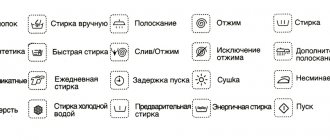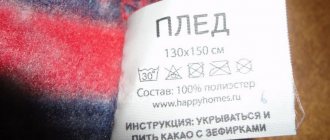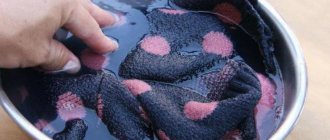What factors determine the washing time in a washing machine?
Let's look at this issue using a practical example (if your washing machine has a digital time display, then you can easily experiment without turning on the machine).
So, let’s turn on the “Cotton” mode - it is available on most models (further the indicators will be given for the “VEKO” washing machine; for others they will not be much different).
What do we see?
- total time: 1h.57m;
- temperature: 60°C;
- spin: 1000 rpm.
Let's set the temperature to 90 oC. We see that the process time has increased to 2h.26m. At t=40 oC the time will decrease to 1h.37m, at t=30oC – to 1h.32m.
Let's change the spin parameters. What do we see? When changing the number of revolutions, the total time does not change; it decreases only if the spin is turned off altogether.
Let's turn on the additional "Soak" function. The total time increased from 1.57 to 2.14.
Thus, using the example of one mode, we saw that its duration strongly depends on the heating temperature of the water, increases with the inclusion of the additional “Soaking” function and is absolutely independent of the number of revolutions during the spin cycle.
Of course, in machines from other manufacturers, the spin time may increase with increasing speed, but 2-5 minutes will not save anyone. In addition, it should be mentioned that the duration of the wash does not depend on the load on the drum; in some new models, the weight of the loaded laundry affects the consumption of water and detergent.
In the “Cotton” mode, it is recommended to wash cotton, linen and similar fabrics, or, more simply, fabrics that can be washed in very hot water and wring out well. When turning on the “Soak” function, do not forget to pour the powder into the appropriate powder section (read the instructions for your washing machine).
Let's look at other basic washing modes that are available on almost all machines.
“Cotton Eco” or similar – lasts about 3 hours depending on the model
As the manufacturers say, in this mode the machine washes very carefully and carefully, with preliminary soaking in warm water and thorough rinsing.. The “baby underwear” mode has approximately the same characteristics - after all, children’s clothes should be washed carefully and carefully, every mother knows this
The “children’s underwear” mode has approximately the same characteristics - after all, children’s clothes should be washed carefully and carefully, every mother knows this.
By the way, these modes include a pre-washing or soaking function, and for this you need to specifically pour the powder into the appropriate section of the powder tray, as mentioned above. If you don’t do this, then for the first half hour your things will simply be rinsed in warm water.
Let's look at other most common operating modes of modern widespread washing machines:
- Synthetic fabrics - lasts 1.5-2 hours, temperature limit is 40°C, and you cannot add the temperature manually, as in the “Cotton” mode;
- Wool or silk - duration about 50 minutes, spin limit - 600 rpm;
- Hand wash – lasts about an hour, heating limit – up to 30°C, spin – 600 rpm.
There are some other modes depending on the model and brand, for example, “Mix”, “Shoes”, “Curtains”, “Jeans” - each manufacturer tries to make their product the best and most attractive, endowing it with “irreplaceable” functions.
Duration of washing modes
What makes up the time of one washing cycle is more or less clear, let’s now consider the most common programs and modes, and see what their duration may be. In this case, we will talk about a specific mode and its built-in parameters, which can be changed manually, namely temperature, spin speed, this, as we have already noted, also affects the washing time. Most washing machines have the following modes:
For some of these modes, you can set additional functions, such as super rinse, pre-wash, which means that you need to add another 15 to 30 minutes to the time indicated above.
Does washing time depend on the type and model of washing machine?
The answer to this question is obvious; of course, the washing time depends on the model of the automatic washing machine. In modern models, the manufacturer tries to reduce energy consumption as much as possible, reducing the duration of washing modes, thereby making the machine economical. But on average, this time still differs by 20-30 minutes. You can find more accurate washing times for a specific mode in the instructions for the washing machine, and if you do not have a printed version of the instructions, you can find them on the Internet.
As for the type of loading of the washing machine, it does not affect the duration of the wash. and with front loading have similar modes, the duration of which may differ, but not significantly. Both have a quick wash mode and an intensive wash mode.
For those who care about the duration of the wash, it is best to choose those models of washing machines whose display shows the remaining wash time. In addition, the delayed washing function will be convenient, which assumes that the machine will start on its own after a period of time from 3 to 19 hours.
So, washing time in an automatic machine can range from 15 minutes to 4 hours. Everything will depend on the combination of parameters and factors that we listed above. Do your laundry correctly and with pleasure!
One of the first to introduce direct drive technology. The concept of attractive design and functionality has been successfully brought to life. Therefore, many users prefer equipment from this brand. In addition to the efficient operation of internal components, electronic control offers various washing modes in the LG washing machine. Our article will help you figure out which one to choose.
Running programs
The symbols on the control panel look more stylish, the icons take up less space, but users are often confused and cannot decide which mode the symbol corresponds to. To decrypt, you constantly need instructions for the machine. Moreover, the drawings are not standardized, and each manufacturer creates them at their own discretion. This is why it is so difficult to switch from a machine of one brand to a model of another brand.
As for Beko washing machines, their control panel is full of inscriptions. Perhaps because of this, the machine does not look so stylish and impressive, but the user does not get confused in the programs. However, you will have to find out the description of the modes, namely such parameters as: washing time, water heating temperature, spin speed. Before starting the “cycle”, you should understand the purpose of special programs.
Let's present a description of the special. programs found on Beko machines.
- Cotton. Designed for washing cotton linen, the water heating temperature varies from 60 to 90 degrees. Ideal for cleaning heavily soiled durable fabrics. Spinning of things occurs at maximum speed. The cycle duration is approximately 2-2.5 hours.
- Eco-cotton. A program designed for washing cotton fabrics with minimal electrical energy consumption. The duration of the cycle is about three hours.
- Dark fabrics. This mode is ideal for synthetic and cotton items in matching shades. The water is heated to a maximum of 40°C, thereby preventing the products from shedding. Washing time – 1 hour 40 minutes.
- Synthetics. The program starts when washing synthetic clothes and combined fabrics. The moderate heating temperature of the liquid prevents shedding and deformation. Cycle duration is 105-120 minutes.
- Shirts. The water is heated to a maximum of 40°C, spinning is performed at low speed. The program prevents the formation of wrinkles on shirts. Washing takes approximately 2 hours.
- Mix 40. General mode in which there is no need to separate laundry into batches according to fabric type. Can be used for washing both synthetics and cotton. The cycle duration is adjustable.
- Express. Suitable for lightly soiled items. The water warms up to 40°C, the spin speed can be adjusted. Washing takes about one and a half hours.
- Pooh. Special program for cleaning blankets and outerwear with appropriate filling. Can be used to “scroll” regular products. Washing time – 60 minutes.
- Sport. Used for cleaning sports uniforms. Suitable for removing hard-to-wash stains and coping with the unpleasant odor of sweat. Cycle duration is from 100 to 140 minutes.
- Mini. The mode starts when a small batch of lightly soiled laundry is loaded into the machine. The operating time of the washing machine is from 30 to 90 minutes, depending on the water heating temperature set by the user.
- Handwash. Program for gentle care of delicate fabrics. Prevents item deformation and wear. The cycle lasts approximately 40-55 minutes.
- Wool. The mode is designed specifically for cleaning woolen products. The “dumping” of the material is eliminated due to the slow rotation of the drum. Washing time is about 70 minutes.
- Kids' things. Involves thorough rinsing of laundry. Washing takes place in hot water, cycle duration is 2 hours 40 minutes.
- Self-cleaning. The mode required for the washing machine to be “washed” from the inside. It starts "idle". The program execution time is 2 hours.
- Jeans. Ideal for denim items, eliminates shedding of products. The duration of the mode is 100-105 minutes.
- Refreshing wash. For lightly soiled clothes. Fights unpleasant odors. The machine runs for only 17 minutes.
- Economy mode. Wash in cool water (20°C), suitable for slightly dirty laundry. It is advisable to replace the powder with a readily soluble liquid product. Cycle duration is 100 minutes.
The duration of the cycles is approximate, in fact the time may “shift” on different Beko models. The exact washing duration, as well as the water heating temperature and spin speed when choosing a specific program, should be found in the instructions for the washing machine.
Wool shrinkage
All of the above recommendations help maintain the original appearance of the product. But sometimes you need to wash an item - for example, a wool sweater - so that it shrinks. For this, the following technology is used:
- Dip the sweater in soapy water heated to 50-60 degrees for 10 minutes.
- Wash it as usual.
- Rinse in cool water (15-20 degrees).
It is important not to allow too sudden temperature changes, otherwise the shrinkage will exceed all expectations. A woolen jacket can shrink by 3-4 sizes and turn from excessively large to small
In addition, you should remember to be careful when spinning and drying. In hot water, the pile fluffs up and becomes especially easily deformed.
Woolen items require careful handling and additional energy consumption for washing. But they reliably retain the body heat of their owner and look beautiful. Therefore, it is worth trying to remember simple rules for caring for hair. It's not difficult - there are only 5 most important points!
What factors determine washing time?
Any model of washing machine performs the task in several stages:
- The main stage of washing.
- Rinsing things.
- Spinning clothes.
The duration of a certain cycle depends on several factors. For example, the higher the temperature set by the manufacturer or user, the longer the washing cycle will be. If fast mode is selected at a temperature of 30 0 C, then the duration will be short.
The extra rinse option also increases the wash duration. On average, this add-on adds 20 to 40 minutes to the task completion time. The machine will need more time to perform a high-quality spin. For example, if the machine spins things at 800 rpm per minute, then it takes an average of 12 minutes to complete this stage. If the spin is selected at 1000 per minute, it will take 15 minutes.
The following options also increase the time it takes to complete a task with a Bosch washing unit:
- The extra wash option adds 15 to 30 minutes.
- Likewise, the soaking process increases the time.
- Heating water to 95 0 C.
- Boiling things.
- In many innovative washing units from LG and Bosch, the washing duration increases depending on the weight of the items loaded into the tank.
- The dirtier the items, the longer the washing process.
Water temperature
Washing on the “Cotton” program involves processing laundry at high temperatures. Its maximum value is 90 degrees. However, such heating is only permissible for caring for white, durable fabrics made from natural cotton. Other materials may be damaged during prolonged heating. The main danger is deformation of products and their shedding.
Manufacturers of all washing machines provide users with the ability to change the heating temperature. It can be reduced to 60, 40 or 30 degrees . This is especially true if the fabric contains other fibers in addition to cotton, or the items are not too dirty.
How to iron and dry clothes after washing
Wäschetrockner, BaWa 004
It is worth noting that gentle washing alone is not enough to preserve the original appearance of products. It is recommended to dry and iron clothes properly.
Tips for drying delicate materials:
- if you did not use a spinner, hang things on hangers over the bathtub and let the water drain;
- Never dry wet items on a line in a bent state or attach them with clothespins;
- either hang the product on hangers or lay it out on a horizontal, preferably mesh, surface;
- to speed up the process, do not place clothes on a radiator or other sources of artificial heat;
- Do not leave light-colored laundry to dry in the sun; try to hang the items in the shade;
- Place the guipure and lace on a flat horizontal surface and cover with absorbent material.
Tips for ironing delicate fabrics:
- for processing, use a high-quality iron with a clean and smooth sole;
- first, try ironing an inconspicuous area of the material with a slightly warm iron, see if the treated area is deformed;
- iron wool at a maximum of 180 degrees only through slightly damp cotton fabric;
- Either do not iron synthetics at all, or set the iron temperature to 110 to 130 degrees, and process only through cotton fabric;
- Iron the organza through a thick sheet of paper at a temperature of 100 to 110 degrees;
- iron silk clothes from the inside out slightly damp, setting the iron temperature to a maximum of 160 degrees; if the material is dry, to prevent streaks from appearing, do not spray the fabric, but moisten it by wrapping it in a damp towel;
- It is better not to iron velvet items, but to treat them with steam from a steam generator or by hanging the item over a bathtub with hot water;
- products made of nylon and elastane cannot be ironed;
If you are unsure of the type and origin of the material, look at the label on the product. The crossed out iron icon means that ironing clothes is prohibited, and the number of dots in the center indicates the degree of heating of the device.
Rules for caring for the device
The machine will last a long time and without problems if you care for it properly:
- install on a perfectly flat horizontal surface - this will eliminate vibration and wear;
- ensure water connection with the required pressure, install the drain hose correctly;
- avoid overloading during washing;
- do not clog the drum and drain hoses with debris or small objects;
- wash items with metal parts in bags;
- use machine detergents.
Between washes, you need to let the machine rest for several hours to prevent overheating and rapid aging.
What preventive maintenance work is required:
- Ensure the safety of the rubber seals, avoid compression and tearing, and wash with a soft sponge.
- Do not use aggressive agents for cleaning the outside and inside, which can damage plastic and rubber.
- Clean powder containers and wash out any remaining detergents.
- After finishing washing, leave the hatch open so that the parts dry in the air and odors and dampness do not accumulate in the body.
- Do not store dirty laundry in the washing machine.
- Regularly clean the casing of debris by removing the bottom panel.
- Check the condition of the water and drain hoses for damage or disconnection.
- You can improve the quality of water coming from your tap water by installing a filter.
- Do not use folk descalers to clean the machine, but only those recommended by the manufacturer (Calgon).
- If there are problems with the water in the tap - low pressure, dirty, sandy or rusty - it is better to postpone the washing or stop it (“Pause”) if it has already started.
Once a year, the machine without laundry is run at high temperatures with powder and cleaner to descale the drum and clean the filter.
An automatic machine is an ideal assistant for washing. Any housewife can master its use. You need to carefully study the instructions and control panel in order to take advantage of all the capabilities of this convenient household appliance. Knowledge of all modes, the ability to set the most effective and necessary washing program will save time and help reduce water and energy costs.
Share link:
How to reduce washing time?
Let's look at this issue using a practical example (if your washing machine has a digital time display, then you can easily experiment without turning on the machine).
What do we see?
- total time: 1h.57m;
- temperature: 60°C;
- spin: 1000 rpm.
Let's set the temperature to 90 oC. We see that the process time has increased to 2h.26m. At t=40 oC the time will decrease to 1h.37m, at t=30oC – to 1h.32m.
Let's turn on the additional "Soak" function. The total time increased from 1.57 to 2.14.
Thus, using the example of one mode, we saw that its duration strongly depends on the heating temperature of the water, increases with the inclusion of the additional “Soaking” function and is absolutely independent of the number of revolutions during the spin cycle.
Of course, in machines from other manufacturers, the spin time may increase with increasing speed, but 2-5 minutes will not save anyone. In addition, it should be mentioned that the duration of the wash does not depend on the load on the drum; in some new models, the weight of the loaded laundry affects the consumption of water and detergent.
In the “Cotton” mode, it is recommended to wash cotton, linen and similar fabrics, or, more simply, fabrics that can be washed in very hot water and wring out well. When turning on the “Soak” function, do not forget to pour the powder into the appropriate powder section (read the instructions for your washing machine).
The “children’s underwear” mode has approximately the same characteristics - after all, children’s clothes should be washed carefully and carefully, every mother knows this.
By the way, these modes include a pre-washing or soaking function, and for this you need to specifically pour the powder into the appropriate section of the powder tray, as mentioned above. If you don’t do this, then for the first half hour your things will simply be rinsed in warm water.
Let's look at other most common operating modes of modern widespread washing machines:
- Synthetic fabrics – lasts 1.5-2 hours, temperature limit is 40°C, and you cannot add the temperature manually, as in the “Cotton” mode;
- Wool or silk – duration about 50 minutes, spin limit – 600 rpm;
- Hand wash – lasts about an hour, heating limit – up to 30°C, spin – 600 rpm.
- As mentioned above, washing time significantly depends on the heating temperature of the water, so set the maximum temperature only in exceptional cases. For cotton, linen and similar fabrics, 60°C is quite enough.
- For the “quick” washing mode, do not set the temperature above 40°C, since heating the water is absolutely pointless - the program is too short, and you will spend extra time and money on electricity.
- If you know at what temperature a particular item should be washed, at what speed it should be wrung out, and whether pre-soaking is necessary, then you can easily adjust the necessary washing parameters on the same “Cotton” mode, and the time will be optimal. After all, most modes are just variations to lure the buyer.
- Try using a delayed start - it is not necessary to let the machine wash when you are at home. The main thing is to be there when the laundry is washed so that it can be hung to dry. For example, you can set a timer in the evening so that you can take out the laundry when you wake up. Or vice versa, set the timer in the morning so that the machine finishes washing when you come home from work.
- One of the cases of increasing washing time can be called “overwashing”. In order not to waste time on re-washing, you need to choose the right operating mode - it’s better to wait an extra 20 minutes than to then re-wash for an hour and a half with the appropriate state of mind. As already mentioned, very often after the express mode, powder stains remain on things, so it’s better to immediately rinse again - you’ll save time and your nerves.
And a couple more tips. Before putting bulky and poorly wetted items into the drum of the washing machine, for example, a bologna jacket, down jacket, pillow, I would advise you to pre-wet them, especially if the washing machine is small. The fact is that such things, when dry, occupy the entire cavity of the drum, do not get wet, and the ribs of the drum do not mix them.
To ensure that your laundry is always perfectly clean, use high-quality detergents - powders, gels, conditioners. Bad powder means not only unwashed items, but also the appearance of new stains that are removed by repeated rinsing. It is better to use liquid gel - pour it directly into the drum along with the laundry you are loading.
Secondary functions
In addition to the main and additional washing modes, in Ariston washing machines you can only select auxiliary functions, for example, only drain or rinse.
- Additional rinse. When this option is activated, the washing machine will perform one more rinse during operation. This is necessary to completely remove the detergent from the fabrics. This possibility is relevant for small children, people with sensitive skin or allergies, and also simply in cases where the detergent was added in more quantity than necessary.
- Individual mode. Allows you to store your own program in the washing machine’s memory, selecting all the necessary parameters for it.
- Spin only. As a rule, the user can independently select the speed when activating this option. This function may be relevant if, after completing a program, the laundry turns out to be very damp or for hand-washed clothes. This option can also be activated after a night wash has been completed, during which the Ariston machine operates very quietly, excluding all spin stages, both main and intermediate.
- Drain. This function can be used in the event of an emergency need to drain water from the tank, as well as in the event of a breakdown of the Ariston machine, when the equipment refuses to drain the liquid from the tank.
What does a full cycle consist of?
The sequential execution of the usual stages - washing, rinsing and wringing out things - constitutes a full cycle of operation of the machine. The device allows you to regulate the specifics of these operations.
Wash
The choice of washing mode is determined by the following parameters:
- fabric structure;
- the presence of decorative elements on products;
- contamination (you can include soaking, boiling cotton fabrics).
The right choice will determine not only how well things are washed, but also possible damage to the laundry from the aggressive effects of temperature and high speeds.
Rinsing
When rinsing, detergents are washed out of fabrics. Many people prefer to run an additional rinse mode to thoroughly wash the laundry from powder.
Spin
Choosing the right spin is the key to easy and enjoyable ironing. Only cotton fabrics should be spun at high speeds. Linen, silk, and synthetics should not be wrung out too much so as not to damage the fabric and make ironing easier.
Delicate laundry detergents
To gently wash clothes, washing machine manufacturers recommend using special detergents. These can be various gels for washing delicate types of fabrics, as well as other liquid products. Moreover, such products should not contain enzymes, phosphates and chlorine. Such products are well rinsed from fabrics, leaving the structure and color of the fabric in its original form.
Conventional powders spoil the color of products, and bleaches worsen their quality. For delicate washing you need special products without dyes and preservatives. The smell of such products is natural; they have a special marking indicating the type of fabric for gentle washing.
You can take products that contain lanolin; it has a mild effect on textiles while preserving the color of things. On the shelves of household chemical stores today you can also see special products that differ in purpose based on the type of fabric. Woolen and silk items cannot be washed with regular powder. For them you need to buy a liquid product for natural fabrics.
Gels are considered the best choice. They penetrate deeper into the fabric structure, are easier to wash out of it, and contain additives to maintain shape and soften water. Gels are suitable for removing various types of stains. They are safe and do not cause allergic reactions. You need to buy biodegradable products from the store. Among the many varieties of these products, one can note products from Nordland, Sion, Laska, and Cashmere.











